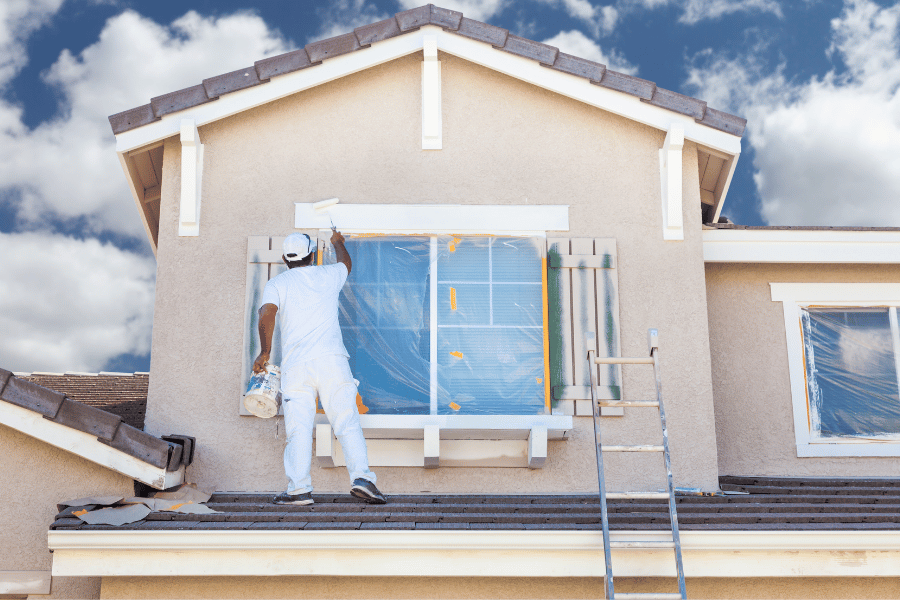If you’re considering repainting your home, you’re not just limited to traditional options. Advances in paint technology have brought about new products that offer improved durability, enhanced aesthetics, and even health benefits.
These innovations are changing the way we think about paint, providing homeowners with options that go beyond just color. Here, we’ll explore some of the latest breakthroughs in house paint technology that can transform your living space in more ways than one.

Self-Cleaning Paints
One of the most exciting innovations in recent years is self-cleaning paint. This type of paint is designed to resist dirt and grime, keeping your walls looking fresh and clean with minimal effort.
How does it work?
Self-cleaning paints typically contain microscopic titanium dioxide particles. These particles use the power of sunlight to break down organic material that lands on the painted surface. When it rains, the dirt and debris are washed away, thanks to the paint’s hydrophilic properties, which spread water evenly over the surface for efficient cleaning.
This technology is particularly beneficial for exterior applications, where weather and environmental conditions can cause dirt buildup. Imagine having a house that looks newly painted even years after the last coat—self-cleaning paints can make this a reality.
Antimicrobial Paints
In an era where health and hygiene are top priorities, antimicrobial paints offer a significant advantage. These paints are infused with antimicrobial agents that inhibit the growth of bacteria, mold, and mildew on the painted surface. Ideal for kitchens, bathrooms, and children’s rooms, antimicrobial paints help maintain a cleaner environment, reduce odors, and potentially lower the risk of allergen exposure.
These paints are particularly popular in commercial settings, like hospitals and schools, but they are making their way into residential homes as homeowners become more health-conscious. Using antimicrobial paint can contribute to a healthier living environment, providing peace of mind alongside aesthetic appeal.
Low-VOC and Zero-VOC Paints
Volatile Organic Compounds (VOCs) are chemicals commonly found in traditional paints that can release harmful fumes into the air, impacting indoor air quality.
Advances in paint formulation have led to the development of low-VOC and zero-VOC paints, which emit fewer toxic gases, making them a healthier choice for both the environment and the people in your home.
These eco-friendly paints are now available in a wide range of colors and finishes, without compromising on performance or appearance. They offer good coverage, durability, and are easy to clean, making them suitable for any room in your home. By choosing low-VOC or zero-VOC paints, you’re contributing to a healthier environment while still enjoying beautiful, long-lasting walls.
Smart Paints and Thermochromic Coatings
Imagine a paint that changes color based on temperature or even one that can conduct electricity. Smart paints and thermochromic coatings are pushing the boundaries of what paint can do.
Thermochromic paints contain special pigments that respond to changes in temperature by altering their color. These can be used for both aesthetic effects and practical applications, such as temperature indicators in children’s rooms or energy-efficient coatings that help regulate indoor temperatures.
Conductive paints, another form of smart paint, can turn any surface into a conductive one, opening up possibilities for integrating electronics and smart home technologies directly into the walls. While these are more commonly seen in commercial or industrial applications, they hint at the future of smart homes and how paint can play a role in home automation.
Nano Paints
Nanotechnology has made its way into the paint industry with nano paints, which incorporate extremely small particles to improve performance characteristics.
Nano paints offer enhanced durability, scratch resistance, and UV protection, which means they can keep your home looking better for longer. These paints can also provide self-healing properties, where minor scratches and imperfections repair themselves over time, maintaining a flawless finish.
Another advantage of nano paints is their ability to reduce heat absorption. By reflecting a greater amount of infrared radiation, these paints can help keep buildings cooler, which is a significant benefit in hot climates. This not only improves comfort but also contributes to energy efficiency by reducing the need for air conditioning.
Conclusion
The latest innovations in house paint technology offer much more than just color—they provide solutions that enhance durability, improve aesthetics, and even promote healthier living environments. From self-cleaning and antimicrobial paints to low-VOC options and smart paints, these advancements are reshaping the possibilities for residential painting projects.
As you consider your next home improvement, exploring these cutting-edge paint technologies can help you make informed choices that align with your needs and values, ensuring your home looks great and functions even better for years to come.

Leave a Reply